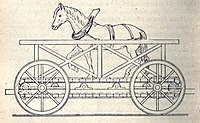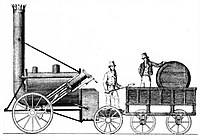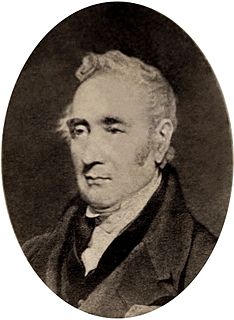
George Stephenson was an English civil engineer and mechanical engineer. Renowned as the "Father of Railways", Stephenson was considered by the Victorians a great example of diligent application and thirst for improvement. Self-help advocate Samuel Smiles particularly praised his achievements. His chosen rail gauge, sometimes called "Stephenson gauge", was the basis for the 4 feet 8+1⁄2 inches (1.435 m) standard gauge used by most of the world's railways.

Stephenson's Rocket is an early steam locomotive of 0-2-2 wheel arrangement. It was built for and won the Rainhill Trials of the Liverpool and Manchester Railway (L&MR), held in October 1829 to show that improved locomotives would be more efficient than stationary steam engines.
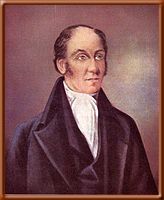
Timothy Hackworth was an English steam locomotive engineer who lived in Shildon, County Durham, England and was the first locomotive superintendent of the Stockton and Darlington Railway.

The Liverpool and Manchester Railway (L&MR) was the first inter-city railway in the world. It opened on 15 September 1830 between the Lancashire towns of Liverpool and Manchester in England. It was also the first railway to rely exclusively on locomotives driven by steam power, with no horse-drawn traffic permitted at any time; the first to be entirely double track throughout its length; the first to have a signalling system; the first to be fully timetabled; and the first to carry mail.

Robert Stephenson FRS HFRSE FRSA DCL was an English civil engineer and designer of locomotives. The only son of George Stephenson, the "Father of Railways", he built on the achievements of his father. Robert has been called the greatest engineer of the 19th century.

Sans Pareil is a steam locomotive built by Timothy Hackworth which took part in the 1829 Rainhill Trials on the Liverpool and Manchester Railway, held to select a builder of locomotives. The name is French and means 'peerless' or 'without equal'.

Rainhill is a large village and civil parish within the Metropolitan Borough of St Helens, in Merseyside, England. The population of the civil parish taken at the 2011 census was 10,853.

Locomotion, previously known as Locomotion: the National Railway Museum at Shildon or Shildon Locomotion Museum is a railway museum in Shildon, County Durham, England. The museum is part of the Science Museum Group.

Cycloped was an early horse-powered locomotive, built by Thomas Shaw Brandreth of Liverpool, which competed unsuccessfully in the Rainhill Trials of October 1829.

An 0-2-2, in the Whyte notation for the classification of steam locomotives by wheel arrangement, is one that has two coupled driving wheels followed by two trailing wheels, with no leading wheels. The configuration was briefly built by Robert Stephenson and Company for the Liverpool and Manchester Railway

Novelty was an early steam locomotive built by John Ericsson and John Braithwaite to take part in the Rainhill Trials in 1829.

Henry Booth was a corn merchant, businessman and engineer particularly known as one of the key people behind the construction and management of the pioneering Liverpool and Manchester Railway (L&M), the world's first steam railway conducting both scheduled passenger services and freight.
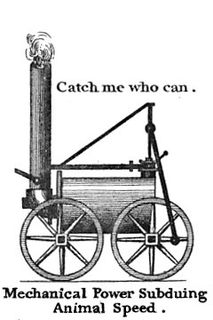
Catch Me Who Can was the fourth and last steam railway locomotive created by the inventor and mining engineer Richard Trevithick. It was an evolution of three earlier locomotives which had been built for Coalbrookdale, Penydarren ironworks and Wylam colliery. Demonstration runs began in July 1808, and Catch Me Who Can was the first locomotive in the world to haul fare-paying passengers.
The history of rail transport in Great Britain to 1830 covers the period up to the opening of the Liverpool and Manchester Railway, the world's first intercity passenger railway operated solely by steam locomotives. The earliest form of railways, horse-drawn wagonways, originated in Germany in the 16th century. Soon wagonways were also built in Britain. However, the first use of steam locomotives was in Britain. The invention of wrought iron rails, together with Richard Trevithick's pioneering steam locomotive meant that Britain had the first modern railways in the world.

Steam Elephant was an early steam locomotive from North East England.
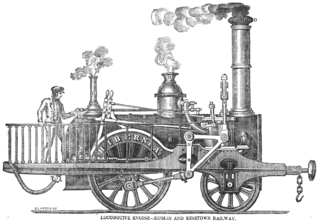
Hibernia was a steam locomotive designed by Richard Roberts and built by Sharp, Roberts and Company in 1834 for the Dublin and Kingstown Railway (D&KR). The locomotive had vertical cylinders driving via bell cranks.

The Liverpool and Manchester Railway (L&M) opened on 15 September 1830. Work on the L&M had begun in the 1820s, to connect the major industrial city of Manchester with the nearest deep water port at the Port of Liverpool, 35 miles (56 km) away. Although horse-drawn railways already existed elsewhere, the Stockton and Darlington steam Railway had been running for five years, and a few industrial sites already used primitive steam locomotives for bulk haulage, the L&M was the first locomotive-hauled railway to connect two major cities, and the first to provide a scheduled passenger service. The opening day was a major public event. Arthur Wellesley, Duke of Wellington, the prime minister, rode on one of the eight inaugural trains, as did many other dignitaries and notable figures of the day. Huge crowds lined the track at Liverpool to watch the trains depart for Manchester.
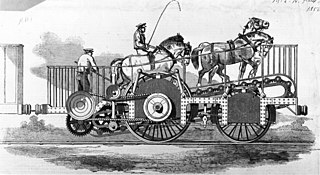
The Impulsoria was a locomotive constructed in 1850 that was powered via a gearbox by two to four horses on a treadmill following a design by Clemente Masserano. It undertook trials in London in 1850 and was exhibited at The Great Exhibition in 1851.
Timothy Burstall (1776–1860) was a British engineer and pioneer in the field of locomotive construction.

The Flying Dutchman was an American horse-powered locomotive operated by the South Carolina Canal and Railroad Company. It was built in New York by engineer Christian Edward Detmold and won an 1830 locomotive competition. Driven by a horse on a treadmill, it could carry 12 passengers at a speed of around 12 miles per hour (19 km/h). The South Carolina Canal and Railroad Company operated the Flying Dutchman on a 6-mile (9.7 km) stretch of track from early 1830. It was replaced by a steam-powered locomotive, the Best Friend of Charleston, by the end of the year.

